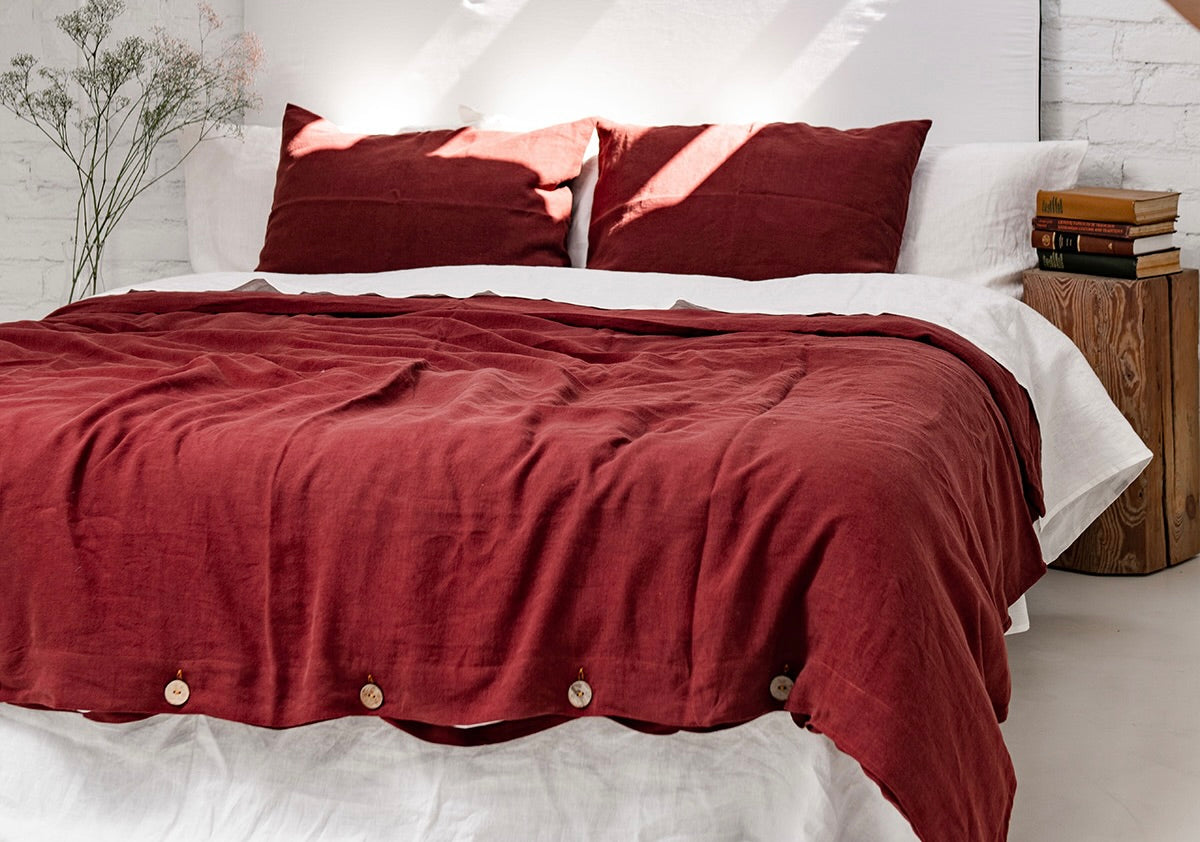Linen is a natural fabric known for its durability, breathability, and timeless beauty. Whether you have one of our linen dresses, beautiful linen bedding, or seamless curtains, proper care is essential to maintain their quality and prolong their lifespan. In this comprehensive guide, we will cover all the aspects of washing and caring for linen.
Checking Care Instructions on Labels
First things first, carefully read and follow the care instructions on labels. Different linen products may have specific care requirements, and it is crucial to understand them to avoid damaging the fabric. Some linen items may be machine washable, while others may require hand washing or delicate cycle. The care label will also provide information on water temperature, recommended detergents, and other special care instructions, such as avoiding bleach or harsh chemicals. Always check the care label before proceeding with washing. At AmourLinen, we take pride in our thoughtfully crafted linen products. Our linen clothing, bedding, and curtains are carefully labeled with detailed care instructions to ensure their longevity.
Hand Washing Linen
Hand washing is the gentlest method to clean linen clothes and bedding, especially if they are delicate or have intricate details. At AmourLinen, although we do appreciate this sort of washing, we understand that most of us don't have the time to do it and thus all of our linen can be looked after with the good old washing machine.
Machine Washing Linen
Most of our linen products, including our versatile linen clothing, sumptuous bedding, and elegant kitchen linens, are conveniently machine washable using a gentle cycle and cold to lukewarm water. Follow these steps for machine washing linen:
- Sort your linen items by color and separate them from other fabrics to avoid color bleeding.
- Use a mild detergent suitable for delicate fabrics, and avoid using bleach or harsh chemicals.
- Use the gentle cycle with a slow spin speed to minimize agitation and reduce the risk of wrinkles or damage.
- Wash linen items in cold to lukewarm water, as hot water can shrink or distort the fabric.
- Once the cycle is complete, promptly remove the linen items from the machine to prevent wrinkles.
- Shake out the items gently to loosen any wrinkles and hang or lay them flat to dry.
Softening Linen Clothes
Linen clothes can sometimes feel stiff after washing, but there are ways to soften them and make them more comfortable to wear. Here are some tips for softening linen clothes:
- Tumble dry: Tumble drying linen clothes on a low heat setting can help soften the fabric and reduce stiffness. Add a few clean tennis balls or dryer balls to the dryer to help fluff up the linen fibers and reduce wrinkles.
- Air drying: If you prefer air drying (just as we do!), hang your linen clothes in a well-ventilated area and gently pull and stretch them while damp to soften the fabric.
- Fabric softeners: You can also use a fabric softener specifically designed for delicate fabrics, but be sure to follow the instructions and use it sparingly, as too much fabric softener can leave a residue on linen.
Drying Linen
Proper drying is essential to maintain the shape and quality of your linen products. Here are some tips for drying linen:
- Air drying: The best way to dry linen is by air drying. After washing, gently shake out the linen items to remove excess water, and then hang them or lay them flat to dry in a well-ventilated area away from direct sunlight. Avoid hanging linen clothes or curtains in direct sunlight for prolonged periods, as it can cause fading and damage to the fabric.
- Tumble drying: If you need to speed up the drying process, you can tumble dry linen items on a low heat setting. However, be cautious not to over-dry them, as linen can be prone to wrinkles and shrinkage when exposed to high heat. Remove the linen items from the dryer while they are still slightly damp and hang or lay them flat to finish drying.
- Ironing: Linen tends to wrinkle easily, and ironing can help to smooth out the wrinkles and give the fabric a polished look. Iron linen clothes or curtains while they are slightly damp, using a medium to high heat setting. Place a clean cloth between the linen and the iron to protect the fabric from direct heat. If you prefer a more relaxed, natural look, you can skip ironing and embrace the natural texture of linen.

Storing Linen Products
Proper storage is crucial to keep your linen clothes and bedding in good condition. Here are some tips for storing linen:
- Clean and dry: Always make sure that your linen items are clean and fully dry before storing them. Any moisture left in the fabric can promote mildew or mold growth, which can damage the linen.
- Fold or hang: Linen clothes can be folded and stored in a cool, dry place, such as a closet or dresser. If you prefer hanging them, use padded hangers to prevent creases and maintain the shape of the garments. Linen curtains should be folded and stored in a dry place to prevent moisture or dust accumulation.
- Avoid plastic: Avoid storing linen items in plastic bags or covers, as plastic can trap moisture and promote mildew growth. Instead, use breathable fabric or cotton storage bags to protect your linen products.
- Rotate: To prevent permanent creases, rotate and refold or hang your linen items periodically, especially if they are stored for a long time.
Removing Stains from Linen
Accidents happen, and linen can get stained... Here are some tips for removing common stains from linen:
- Food stains: When our little joys have too much fun at the table with our kids collection, gently scrape off any excess with a spoon or a blunt knife, then soak the stain in cold water and mild detergent for a few minutes. Rub the stain gently with a soft brush or cloth, and rinse thoroughly with clean water. If the stain persists, you can try applying a paste made of baking soda and water to the stained area, leaving it for 15-30 minutes, and then laundering as usual.
- Wine or coffee stains: We all had this moment happen and your linen clothes are no exception. Immediately blot the stain with a clean cloth to absorb as much liquid as possible. Then, soak the stain in cold water and mild detergent for a few minutes, and rub the stain gently with a soft brush or cloth. Rinse thoroughly with clean water, and launder as usual.
- Oil stains: For oil-based stains, such as grease or makeup, blot the stain with a clean cloth to absorb as much oil as possible. Then sprinkle talcum powder or cornstarch on the stain and let it sit for a few hours to absorb the remaining oil. Brush off the powder and launder as usual.
- Ink stains: Ink stains can be challenging to remove from linen. You can try rubbing alcohol or a mixture of equal parts lemon juice and water to the stain and gently blotting with a clean cloth. Repeat the process until the stain fades, and then launder as usual.
- Blood stains: For blood stains, rinse the stain immediately with cold water and then soak it in a mixture of cold water and mild detergent. Rub the stain gently with a soft brush or cloth, and rinse thoroughly. If the stain persists, you can try soaking it in a mixture of water and enzyme-based stain remover, following the manufacturer's instructions, before laundering as usual.
- Mildew or mold stains: If your linen items develop mildew or mold stains due to improper storage or dampness, you can try soaking them in a mixture of water and white vinegar or lemon juice for a few hours. Then, wash the items with mild detergent and water, and allow them to air dry in a well-ventilated area.
It's important to note that different stains may require different treatment methods, and it's always best to spot test any stain removal technique on a small, inconspicuous area of the linen item before treating the entire stain.
In Conclusion
Proper care and maintenance are essential for keeping your linen clothes, bedding, and curtains in good condition. Follow the care instructions on the label, choose between hand washing or machine washing, air dry or tumble dry on low heat, and store in a clean, dry place. Remember to spot test stain removal techniques and embrace the natural texture of linen. With these tips, you can enjoy the durability, versatility, and timeless beauty of linen products for years to come.
Explore our collections of timeless linen pieces and enjoy the breathability and easy care that linen brings.





Leave a comment
This site is protected by hCaptcha and the hCaptcha Privacy Policy and Terms of Service apply.